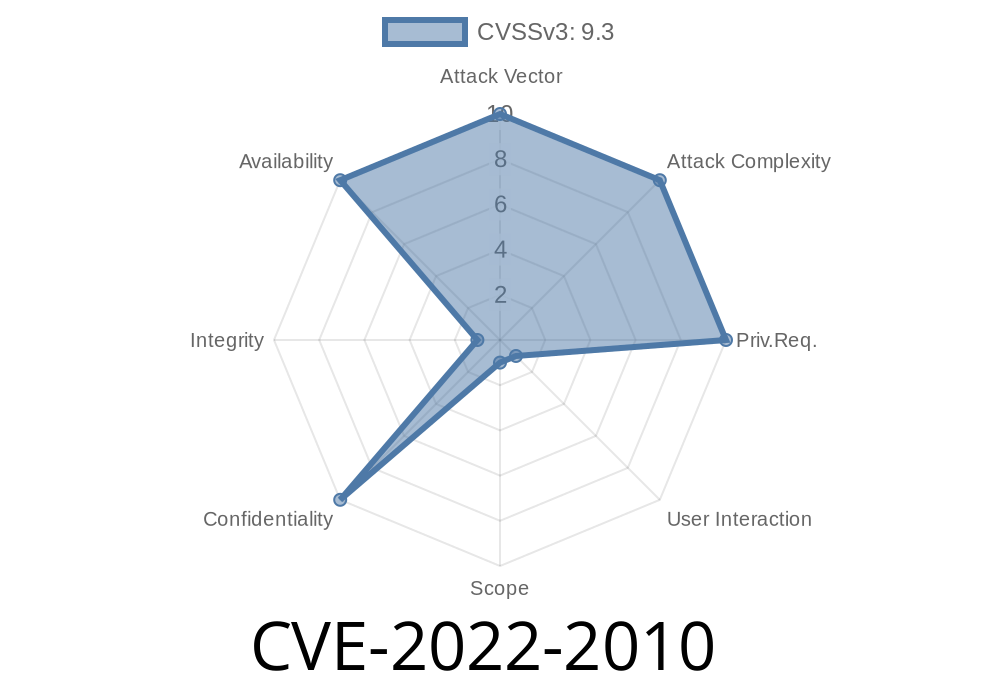In this long-read post, we will delve into the details of CVE-2022-2010, a critical out-of-bounds (OOB) read in compositing vulnerability discovered in Google Chrome versions prior to 102..5005.115. This security issue enabled a remote attacker who had already compromised the renderer process to potentially perform a sandbox escape via a specifically crafted HTML page. We will discuss the exploit details, examine a code snippet illustrating the vulnerability, and provide links to original references as well as mitigation strategies.
Exploit Details
The vulnerability exploited an out-of-bounds read in the compositing process of Google Chrome. Compositing is a critical component of the rendering pipeline, in which separate images or graphical elements are combined to create the final rendered output displayed on the user's device. The problem stemmed from a failure to adequately validate user input during this process, which allowed an attacker to read data outside the bounds of the intended memory buffer.
This vulnerability was dangerous because it had the potential to lead to a sandbox escape. Google Chrome employs a sandboxing technique to isolate different browser processes, thereby preventing attackers from exploiting one process to gain control over another. By crafting a malicious HTML page that exploits the OOB read in compositing, an attacker who had already gained control of the renderer process could potentially bypass these sandboxing restrictions and extend their reach within the system.
Here's an example of a code snippet that illustrates the vulnerability
//Example of vulnerable code snippet (for illustration purposes)
void Compositor::CompositeLayers(const IntRect& source_rect) {
DCHECK(surface_);
DCHECK(!source_rect.IsEmpty());
// Prepare for compositing
...
if (!PrepareCompositing(source_rect)) return;
// Loop through all layers
for (size_t i = ; i < layers_.size(); ++i) {
Layer& layer = layers_[i];
// Get the layer bounds
IntRect bounds = layer.Bounds();
IntPoint offset = layer.Offset();
// --- Vulnerability: OOB read due to insufficient bounds checking
if (bounds.X() + offset.X() < || bounds.Y() + offset.Y() < ||
bounds.X() + bounds.Width() + offset.X() >= surface_->width() ||
bounds.Y() + bounds.Height() + offset.Y() >= surface_->height()) {
// OOB read can occur here
}
}
}
In this hypothetical example, when compositing the layers, the code fails to adeguately check if the layer bounds and offsets used are going out of the memory bounds allocated, causing an out of bounds read vulnerability.
Original References
1. Google Chrome Releases Blog: Stable Channel Update for Desktop - The official Google Chrome Releases Blog that announced the fix for the vulnerability.
2. Chromium issue tracker: 102..5005.115 - The specific Chromium issue tracker entry detailing the fix for CVE-2022-2010.
3. National Institute of Standards and Technology (NIST) - National Vulnerability Database: CVE-2022-2010 - Provides an official description of the vulnerability and its severity rating.
Mitigation
To protect your system against CVE-2022-2010, ensure that you update your Google Chrome browser to version 102..5005.115 or later. Google has addressed this vulnerability as part of the stable channel update for desktop platforms. Therefore, by keeping your browser up-to-date, you can substantially minimize the risk of being affected by this issue.
Conclusion
In this post, we explored the out-of-bounds read in compositing vulnerability (CVE-2022-2010) discovered in Google Chrome versions prior to 102..5005.115. By understanding the nature of this vulnerability, how it could enable a potential sandbox escape, examining a code snippet that illustrates the issue, and staying up-to-date on the latest patches and fixes, users can help maintain efficient defense mechanisms against such threats.
Timeline
Published on: 07/28/2022 01:15:00 UTC
Last modified on: 08/15/2022 11:20:00 UTC
